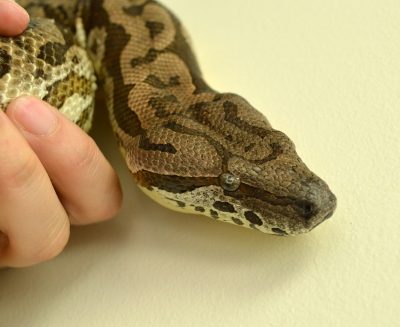
The time has come for the boa constrictor to slither out of the spotlight as our Animal of the Month for February. We had a great time tweeting about this fascinating and popular snake and we hope you enjoyed following us on Twitter @ExoticPetVets. In case you missed any of our tweets, here’s a summary for your reference. Did you know?:
- The boa constrictor’s scientific name is really easy to remember – it’s boa constrictor.
- The “boa” part of the boa constrictor’s name means “large snake” in Latin.
- Boa constrictors are native to northern Mexico, South and Central America as well as several islands in the Caribbean.
- There are about 9 subspecies of boa constrictor, such as the Colombian boa constrictor which is widely kept in captivity.
- In the wild, boa constrictors are found in different habitats ranging from rainforests to semi-desert areas.
- While they’re mostly ground-dwellers, boa constrictors also spend a lot of time in trees, especially when they’re younger.
- Boa constrictors are good swimmers so they are often found near bodies of water like streams and rivers.
- Boa constrictors are ambush hunters. They wait for prey to come close enough to them before striking quickly.
- As their name suggests, boa constrictors put the squeeze on their dinner.
- Boa constrictors will first grab their prey with their teeth and then wrap around the animal and squeeze tightly.
- It’s been believed boa constrictors kill their prey by suffocation, but a recent study has come to a different conclusion.
- New research finds boa constrictor’s grip cuts blood supply to the prey’s major organs which kills faster than suffocation.
- With his prey trapped in his tight grip, the boa constrictor will unhinge his jaw to swallow it whole.
- In the wild, boa constrictors will eat small to medium-sized animals and birds.
- Boa constrictors are very large snakes and can grow to a length of up to 13 feet (3.9 metres).
- Female boa constrictors are typically larger than their male counterparts.
- Because of their size, boa constrictors are also heavy snakes and can weigh up to 100 lbs.
- Female boa constrictors don’t lay eggs. They’re ovoviviparous, which means they give birth to live babies.
- A female boa constrictor can give birth to up to 60 babies at once, but the average litter size is about 25.
- Baby boa contrictors are completely independent when they’re born.
- You’ll never see boa constrictors close their eyes – because they don’t have eyelids.
- Boa constrictors have a transparent scale called a spectacle or brille over each eye that helps protect their eyes.
- When boa constrictors shed their skin, the brille is shed too.
- During the shed cycle, a tear-like substance is secreted under the brille to protect the boa constrictor’s eyes.
- This tear-like substance causes the boa constrictor’s eyes to cloud over during the shed cycle.
- When the boa constrictor’s eyes are clouded over his vision is poor. After the skin is shed his eyesight is normal again.
- There is no reason for people to be scared of boa constrictors. They are non-venomous snakes.
- It’s rare for a boa constrictor to bite a person. If it does happen, it’s in self-defence because he feels threatened.
- Boa constrictors won’t eat humans of any size as people (including small children) are too big to be prey.
- Boa constrictors are typically docile and don’t mind being handled if socialized properly.

